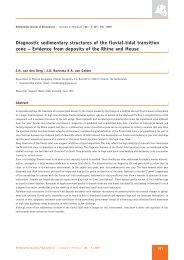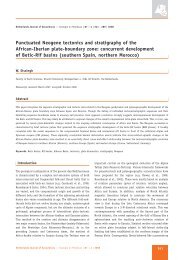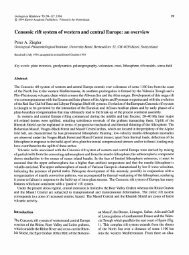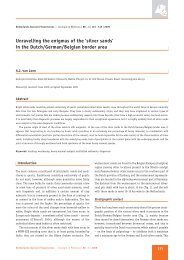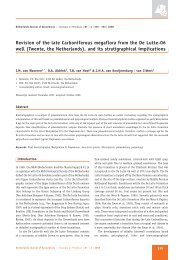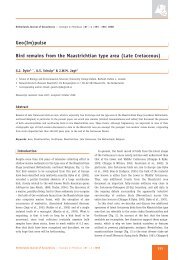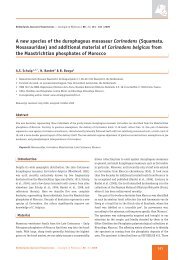full text - Netherlands Journal of Geosciences
full text - Netherlands Journal of Geosciences
full text - Netherlands Journal of Geosciences
Create successful ePaper yourself
Turn your PDF publications into a flip-book with our unique Google optimized e-Paper software.
Description<br />
Institutional abbreviations<br />
TW = Museum Twentse Welle, Enschede<br />
Described material<br />
Four nothosaur skulls from the Diepenbroek collection in the<br />
museum ‘Twentse Welle’, Enschede, with collection numbers:<br />
TW480000375, TW480000376, TW480000377, and TW480000378.<br />
(Photographs in addendum online: www.njgonline.nl).<br />
Referred material<br />
Two additional skulls described as Nothosaurus winterswijkensis<br />
(Albers & Rieppel, 2003), one skull attributed to Nothosaurus<br />
marchicus (Albers, 2005a) and one skull described as Nothosaurus<br />
winkelhorsti (Klein & Albers, 2009).<br />
Stratum typicum<br />
The skulls were found in the Lower Wellenkalk layer 9 (Oosterink,<br />
1986), Vossenveld Formation (lower Anisian, lowermost Middle<br />
Triassic) in the ‘Winterswijkse Steen- en Kalkgroeve, Winterswijk,<br />
<strong>Netherlands</strong>’, a quarry <strong>of</strong> the Ankerpoort consortium; see also<br />
the tectonic map and geological pr<strong>of</strong>iles <strong>of</strong> Harsveldt (1973).<br />
Gauss-Krüger coordinates: R 2252,6/H 5758,6.<br />
General remarks and measurements<br />
All four skulls are relatively small seized. Two skulls, are<br />
complete, one prepared in dorsal view (TW480000375) and one<br />
prepared in ventral view (TW480000376). The third skull is<br />
very incomplete and not diagnostic, its right temporal fenestra<br />
is intact and the corresponding frontal and parietal skull table<br />
and the medial outline <strong>of</strong> the orbits with the front broken <strong>of</strong>f<br />
just posterior to the external naris. A small part <strong>of</strong> the left side<br />
<strong>of</strong> the skull is present but below elements belonging to the<br />
palate eg the pterygoid and the basisoccipital are or appear to<br />
be completely missing. (see photograph in addendum online:<br />
www.njgonline.nl). The fourth skull (TW480000378) is complete<br />
except for most <strong>of</strong> the premaxilla. For estimation <strong>of</strong> sizes the<br />
missing premaxilla was considered to be <strong>of</strong> about equal size as<br />
that <strong>of</strong> TW480000375. See Table 1 for general measurements and<br />
Table 2 for derived measures and dentition. Unless specifically<br />
mentioned otherwise the descriptions below refer to skulls<br />
TW480000375 and TW480000378 when features in dorsal view<br />
are described and refer to TW480000376 when features in<br />
ventral view are described (see Fig. 1) .<br />
Premaxilla<br />
The paired premaxillas have long and slender tapering<br />
posterior processes, which reach far back along the skull<br />
midline, extending beyond the external naris. In dorsal view<br />
the anterior medial margin <strong>of</strong> the external naris is bordered by<br />
the premaxilla. Their posterior medial margin, however, is<br />
separated from the premaxilla by an anterior lateral tapering<br />
process <strong>of</strong> the nasal. The suture between premaxilla and maxilla<br />
is located slightly posterior to the anteroventral corner <strong>of</strong> the<br />
external naris, from where it extends in anterolateral<br />
direction. In ventral view it curves around the alveolus <strong>of</strong> the<br />
anteriormost maxillary tooth until about the height <strong>of</strong> the<br />
anterior margin <strong>of</strong> the internal naris, but remains excluded<br />
therefrom by a contact <strong>of</strong> the maxilla with the vomer at the<br />
anterior margin <strong>of</strong> the latter. The premaxilla carry five tooth<br />
positions, comprising four premaxillary fangs followed by a<br />
distinctly smaller premaxillairy tooth. Several teeth remain in<br />
situ (see figure) as well as one replacement visible in the<br />
alveolus <strong>of</strong> the fourth position on the left side <strong>of</strong><br />
TW480000376.<br />
Maxilla<br />
From posterior to the anteroventral corner <strong>of</strong> the external naris<br />
the maxilla reaches backwards carrying the tooth row until<br />
about 10-15% <strong>of</strong> the length <strong>of</strong> the longitudinal diameter <strong>of</strong> the<br />
upper temporal fenestra. The maxilla has a foramen at the<br />
anterior part along the lateral margin <strong>of</strong> the external naris,<br />
serving the exit <strong>of</strong> a lateral branch <strong>of</strong> the superior alveolar<br />
nerve, as is common in most species <strong>of</strong> Nothosaurus (Rieppel &<br />
Wild, 1996). Laterally the maxilla shows a slight bulge just<br />
behind the level <strong>of</strong> the posterior margin <strong>of</strong> the external naris,<br />
accommodating the roots <strong>of</strong> the maxillary fangs. Behind the<br />
external naris, the maxilla meets the lateral margin <strong>of</strong> the nasal<br />
in a posteromedially trending suture, until it meets the frontal,<br />
as is common for Nothosaurus marchicus (Rieppel & Wild, 1996),<br />
except for the left maxilla <strong>of</strong> TW480000375 were the maxilla is<br />
excluded from the frontal by a small anteromedial process <strong>of</strong><br />
the prefrontal, as typical <strong>of</strong> Nothosaurus winterswijkensis (Albers<br />
& Rieppel, 2003).<br />
In ventral view the maxilla forms the lateral margin <strong>of</strong> the<br />
internal naris and extends posteriorly lateral to the palatine<br />
and the ectopterygoid. The suture between the premaxilla and<br />
the maxilla is clearly identifiable on both sides <strong>of</strong> the skull <strong>of</strong><br />
TW480000376 and indicates four tooth positions (2 teeth in<br />
situ) before the maxillary fangs on the left side <strong>of</strong> the skull and<br />
five tooth positions (3 teeth in situ) before the maxillary fangs<br />
on the right side <strong>of</strong> the skull. Five tooth positions before the<br />
maxillary fangs are diagnostic for Nothosaurus marchicus<br />
(Rieppel & Wild, 1996). Lateral views <strong>of</strong> both other skulls<br />
(TW480000375 and TW480000378) do not seem to accommodate<br />
more room than three tooth positions (with either 1 or 2 teeth<br />
16<br />
<strong>Netherlands</strong> <strong>Journal</strong> <strong>of</strong> <strong>Geosciences</strong> — Geologie en Mijnbouw | 90 – 1 | 2011



